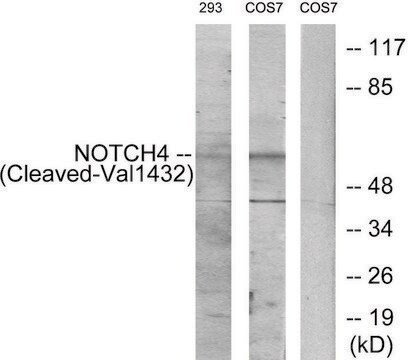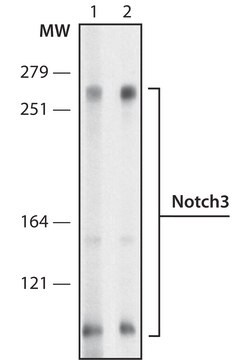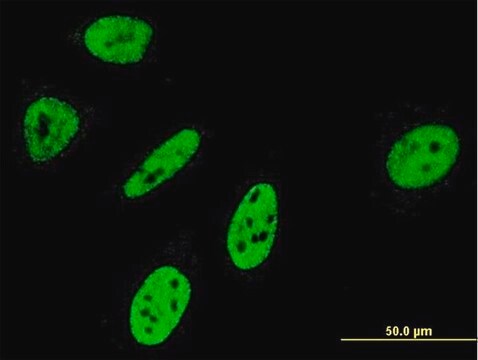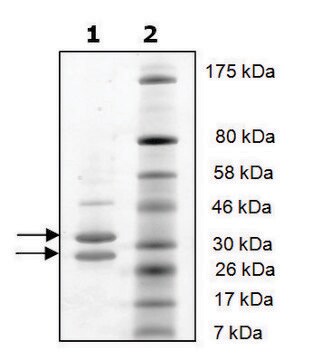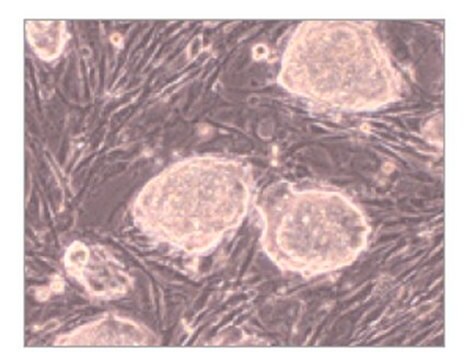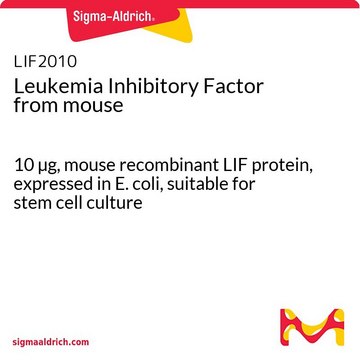MABC594
Anti-NOTCH 3/N3ECD Antibody, clone 1E4
clone 1E4, 1 mg/mL, from mouse
Sinonimo/i:
Neurogenic locus notch homolog protein 3, Notch 3, Notch 3 extracellular truncation, Notch 3 intracellular domain, N3ECD Domain, Ectodermal N3ECD, N3ECD
About This Item
Prodotti consigliati
Origine biologica
mouse
Livello qualitativo
Forma dell’anticorpo
purified immunoglobulin
Tipo di anticorpo
primary antibodies
Clone
1E4, monoclonal
Reattività contro le specie
human
Concentrazione
1 mg/mL
tecniche
electron microscopy: suitable
immunocytochemistry: suitable
western blot: suitable
Isotipo
IgG1κ
N° accesso NCBI
N° accesso UniProt
Condizioni di spedizione
wet ice
modifica post-traduzionali bersaglio
unmodified
Informazioni sul gene
human ... NOTCH3(4854)
Descrizione generale
Specificità
Immunogeno
Applicazioni
Immunohistochemistry Analysis: A representative lot of this antibody was used to detect NOTCH 3 in Huamn vascular smooth muscle cells & smooth muscle cells of vessels from CADASIL brain tissue (Jouet, A., et al. (2000) Journal of Clinical Investigation. 105(5):597-605).
Electron Microscopy: A representative lot of this antibody was used to detect NOTCH 3 in smooth muscle cells of vessels from CADASIL brain tissue (Jouet, A., et al. (2000) Journal of Clinical Investigation. 105(5):597-605).
Immunohistochemistry Analysis: A representative lot of this antibody was used to detect NOTCH 3 in vessels of a CADASIL patient (Rouchox, M.M., et al. (2003) American Journal of Pathology. 162(1):329-342).
Immunohistochemistry Analysis: A representative lot of this antibody was used to detect NOTCH 3 in Human colorectal carcinoma (Serafin, V., et al., (2011) Journal of Pathology. 224(4):448-60).
Apoptosis & Cancer
Developmental Signaling
Qualità
Western Blotting Analysis: 1 µg/mL of this antibody detected NOTCH 3 & the ectodermal domain (N3ECD) in 10 µg of MCF-7 cell lysate.
Descrizione del bersaglio
This antibody detects both the full length NOTCH 3 protein (~260 kDa) and the ectodermal domain N3ECD (~210 kDa).
Stato fisico
Stoccaggio e stabilità
Esclusione di responsabilità
Non trovi il prodotto giusto?
Prova il nostro Motore di ricerca dei prodotti.
Codice della classe di stoccaggio
12 - Non Combustible Liquids
Classe di pericolosità dell'acqua (WGK)
WGK 1
Punto d’infiammabilità (°F)
Not applicable
Punto d’infiammabilità (°C)
Not applicable
Certificati d'analisi (COA)
Cerca il Certificati d'analisi (COA) digitando il numero di lotto/batch corrispondente. I numeri di lotto o di batch sono stampati sull'etichetta dei prodotti dopo la parola ‘Lotto’ o ‘Batch’.
Possiedi già questo prodotto?
I documenti relativi ai prodotti acquistati recentemente sono disponibili nell’Archivio dei documenti.
Il team dei nostri ricercatori vanta grande esperienza in tutte le aree della ricerca quali Life Science, scienza dei materiali, sintesi chimica, cromatografia, discipline analitiche, ecc..
Contatta l'Assistenza Tecnica.
